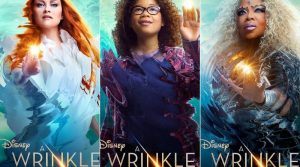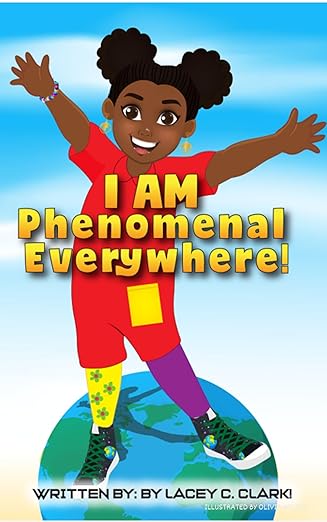(Akiit.com) The science fiction fantasy novel A Wrinkle in Time, written in 1962 by Madeleine L’Engle, won the prestigious Newbery Medal. The author had a fascination with quantum physics and her novel reflected that interest as it explored themes of good versus evil. Initially, over 20 publishers turned down the book.
The author felt that making the protagonist a young female and the subject matter, which skewed adult but was for kids, might have raised concerns. Nonetheless, A Wrinkle in Time was eventually published, became popular, and the original concerns are either the 2018 movie adaptation’s blessing or curse.
Thirteen-year-old Meg Murry (Storm Reid, 12 Years a Slave) is  having a hard time at school. The mean girls bully her, she feels alienated and depressed. The cause of her melancholia is the four-year-long disappearance of her physicist father (Chris Pine, Wonder Woman, Star Trek: Into Darkness). His mysterious absence has left Meg, her precocious little brother Charles Wallace (Deric McCabe) and her mom (Gugu Mbatha-Raw, Belle, Beyond the Lights) bewildered and broken hearted.
having a hard time at school. The mean girls bully her, she feels alienated and depressed. The cause of her melancholia is the four-year-long disappearance of her physicist father (Chris Pine, Wonder Woman, Star Trek: Into Darkness). His mysterious absence has left Meg, her precocious little brother Charles Wallace (Deric McCabe) and her mom (Gugu Mbatha-Raw, Belle, Beyond the Lights) bewildered and broken hearted.
Shortly before he vanished, Mr. Murry was exploring the possibility of tesseracts, wrinkles in time that he thought humans could pierce and ultimately experience intergalactic travel. When things look the bleakest for the siblings, three mysterious otherworldly beings come into the kids lives: the staid Mrs. Which (Oprah Winfrey), the eccentric Mrs. Who (Mindy Kaling) and the flighty Mrs. Whatsit (Reese Witherspoon). The three spirits transport Meg, Charles Wallace and their friend Calvin (Levi Miller, Pan) to worlds within worlds so they can search for Mr. Murry.
That’s the set-up. This screen adaptation, headed by director Ava DuVernay (Middle of Nowhere, Selma, 13th) and written by Jennifer Lee (Frozen) and Jeff Stockwell (Bridge to Terabithia), doesn’t venture too far off the novel’s path, to mixed results. There are moments in the film—e.g. when little Charles Wallace becomes inhabited by an evil being (named “The Black Thing” or “IT”) who causes him to do mean things to his sister—that might frighten little kids. And though the parents love story and the kids love for their dad can appeal to adults, this is a children’s fantasy film, and older people who watch may not be enthralled.
Looking for a long-lost father certainly provides a lot of momentum, and it’s easy to get on board the characters’ quest. Once the journey starts, it is up to the director and the special/visual effects departments to create worlds that entice our imagination. Unfortunately, a mind-boggling netherworld never shows up. In fact, the more fantastical moments are way too bland and obviously CG green screen magic.
Surprisingly, the two eeriest moments are not scenes that feature an evil creature: 1. Kids in unison bounce red balls in a suburban cul de sac with look-a-like houses and are rushed into their homes by Stepford-wifely moms. 2. Meg and Calvin run through a forest and are being chased by a wall of dirt and upheaved earth.
DuVernay was the perceptive artist who brought MLK’s story to life in Selma. She brought truth to the subject of prisons in America in the doc 13th. And her intimate triad love story Middle of Nowhere was very romantic. She seems versatile enough to tackle any genre, but shows no real aptitude for fantasy filmmaking. Veteran directors like Steven Spielberg have a hatful of tricks and production teams that can make their footage captivating, but that is not the case here. Too many stagnant moments. Uneven editing (Spencer Averick). No new effects that set this film apart from others. That said, DuVernay is a brave filmmaker who took on this challenge earnestly. She deserves credit for trying and also casting a young black actress in a lead role that was originally written for a white girl. Regardless of how the film is received, it is changing norms and creating history.
The good news on the acting front is that Storm Reid, Deric McCabe and Levi Miller are delightful to watch. Gugu Mbatha-Raw and Chris Pine exhibit some real chemistry and they make you want to see them together again. Reese Witherspoon as Mrs. Whatsit gives an eccentric performance that enlivens the screen. Mindy Kaling, as Mrs. Who, seems to have less of a game plan and is tepid at best.
Casting Oprah Winfrey as the central figure, Mrs. Which, is the film’s most questionable choice. Way too much of this film’s potential success weighs on this character, and the former talk show host’s portrayal is dull and outwardly unemotional. The lackluster directing and unimaginative production elements make Winfrey’s shortcomings all the more obvious. Costume designer Paco Delgado (Les Misérables) has adorned her with some pretty weird and wonderful threads. The makeup department and hairstylist have tricked her hair out. The opportunity is there to shine, and she doesn’t. Given the same chance, a seasoned thespian like Angela Bassett or Meryl Streep would have found a way to make the character magnetic, even if the film wasn’t.
At one point Mr. Murry utters what could be viewed as the theme of the film: “Love is always there for you even if you don’t feel it.” It is one of the few times that the dialogue doesn’t drift into clichéd, Life Coach catch phrases and hits the mark. More moments like this, that captured the heart of Madeleine L’Engle’s winsome book, could have elevated this film.
Columnist; Dwight Brown
Official website; http://DwightBrownInk.com










Leave a Reply